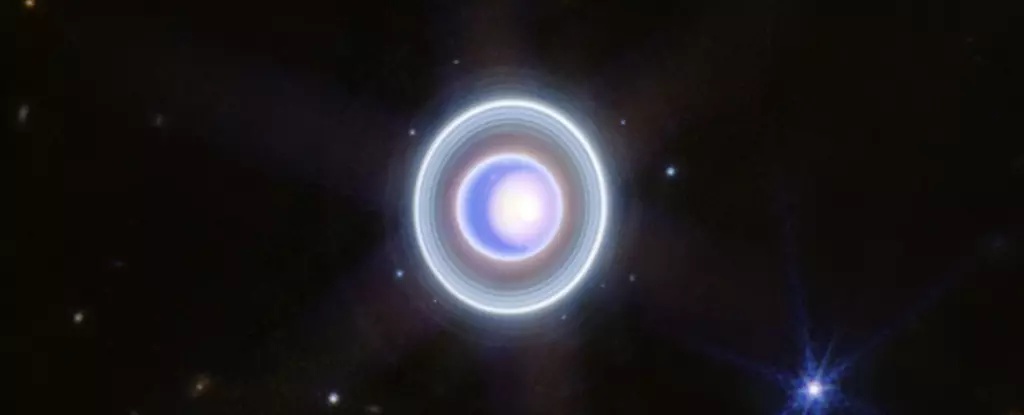The exploration of our Solar System has often been characterized by the multitude of discoveries that challenge our understanding of planetary bodies. Among these celestial wonders, Uranus stands out, exhibiting a variety of unusual features that have puzzled scientists for decades. Traditionally, observations from the Voyager 2 probe—launched by NASA and flyby the ice giant in 1986—have painted a perplexing picture of the planet’s magnetic field and its surrounding magnetosphere. Recent analysis, however, indicates that our understanding of Uranus might have been shaped by an anomalous event in solar activity during the time of the flyby, prompting a need to reevaluate our assumptions about this enigmatic planet.
When Voyager 2 made its historic journey past Uranus, it provided the first close-up observations of the planet. The data collected indicated that Uranus had a magnetosphere that was significantly unlike any other in the Solar System. The magnetic field appeared misaligned and distorted, raising questions about the structure and dynamics of Uranus itself. For many years, scientists believed that these anomalies represented the true nature of Uranus’s magnetosphere. However, questions lingered about whether those measurements could be an anomaly resulting from the specific conditions at the time.
Space plasma physicist Jamie Jasinski, part of NASA’s Jet Propulsion Laboratory team, embarked on a mission to dissect the context of these findings more thoroughly. His skepticism regarding the Voyager 2 observations hinged on one key point: solar activity. In his research, Jasinski focused on the interaction between solar wind and Uranus’s magnetosphere, revealing that solar wind pressure had dramatically increased just prior to the Voyager encounter. This alteration, he posited, likely had a profound impact on the data collected during the flyby.
The revelation that solar wind conditions around Uranus were not typical challenges the long-held view of the planet’s magnetic properties. Jasinski’s detailed analysis found that the pressure from solar outflows increased by a staggering factor of 20 shortly before the probe’s arrival. This drastic change would have compressed Uranus’s magnetosphere to about 20% of its usual volume. As a result, the environment recorded during the Voyager encounter may not reflect the planet’s typical conditions.
This phenomenon mirrors past observations made of Mercury, during which temporary solar events transformed the magnetic field dynamics around the planet. Jasinski’s experience with the MESSENGER mission taught him that such fleeting solar influence could lead to radically different findings. Consequently, he hypothesized that Voyager 2’s observations were merely snapshots of an extraordinary moment in time, rather than an accurate representation of Uranus’s typical magnetic field behavior.
These findings bear significant ramifications for how scientists approach the understanding of Uranus and similar planets. If future investigations confirm that Uranus’s magnetosphere is generally stable and resembles other gas giants, researchers will need to reassess previous assumptions about the planet’s internal structure and magnetic field generation processes. For instance, instead of viewing Uranus as an anomaly within our Solar System, it could be classified alongside Jupiter, Saturn, and Neptune, which possess more conventional magnetic field structures.
Moreover, Jasinski’s analysis reveals the urgent need for dedicated missions to Uranus and Neptune. The limitations of a single Voyager flyby significantly hamper our understanding. A sustained observational campaign would yield comprehensive data that could unravel more secrets about Uranus, including its moons, atmosphere, and physical characteristics.
As the scientific community acknowledges the dynamic nature of our Solar System, these discoveries underline an essential truth: our observations are often mere glimpses tinted by circumstances beyond our control. The surprising nature of Uranus’s magnetosphere might only be the tip of the iceberg. With technology advancing at a rapid pace, the prospects of returning to Uranus with advanced missions loom tantalizingly closer.
The recent reassessment of the Voyager 2 findings on Uranus is more than just a technical adjustment; it marks a significant shift in our understanding of the planet. By considering the influences of solar activity on historical observations, we can better appreciate the complexities of Uranus and create pathways for future exploration that will deepen our understanding of our Solar System’s mysteries. The case of Uranus is a reminder to scientists that what we see in the cosmos is, indeed, an ever-changing tableau shaped by myriad forces.


Leave a Reply